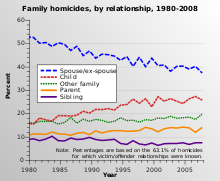Patrizid

Ein Patrizid (aus lateinisch pater „Vater“ und caedere „töten“) ist die Tötung des eigenen Vaters durch den Sohn oder die Tochter.[1][2]
In der griechischen Mythologie gibt es viele Motive des Vatermords. Bekannt ist Ödipus, der seinen Vater Laios von Theben tötet. Patrizide gibt es auch in den hinduistischen und chinesischen Sagenwelten. Die Edda erzählt, wie Fafnir aus Habgier den ebenso gierigen Hreidmar besiegt. Im Alten Testament wird das Schicksal des assyrischen Königs Sanherib behandelt, der gegen David gekämpft hatte (2 Kön 19,37 und Jes 37,38 ). In alten Kulturen hatte der Familienvater eine Sonderstellung als Ernährer, Besitzer und Alleinherrscher, was Angriffe gegen ihn besonders unerhört machte. Im alten Rom gab es deshalb für Vatermörder eine eigene grausame Hinrichtungsart, das Säcken.[3]
Historische Fälle von Patriziden haben oft Aufsehen erregt. Häusliche Gewalt gegen enge Verwandte ist selbst heute noch stark emotional besetzt. Dabei sind solche Vorkommnisse nicht selten; 2008 richteten sich in den USA 13 % der Tötungsdelikte im häuslichen Bereich gegen Elternteile.[4]
Siehe auch
- Ödipuskonflikt
- Matrizid (Tötung der Mutter)
Literatur
- Erich Simenauer: Vom Paricidium zum Patricidium. In: Jahrbuch der Psychoanalyse, Jg. 14 (1982), S. 62–83.
Einzelnachweise
- ↑ Marc Allroggen: Praxishandbuch forensische Psychiatrie des Kindes-, Jugend- und Erwachsenenalters: Grundlagen, Begutachtung und Behandlung. Med.-Wiss. Verlag-Ges., 2011, ISBN 978-3-941468-25-2, S. 125 (google.com).
- ↑ Norbert Nedopil: Forensische Psychiatrie: Klinik, Begutachtung und Behandlung zwischen Psychiatrie und Recht ; 69 Tabellen, Georg Thieme Verlag, 2007, S. 263 [1]
- ↑ Jens-Uwe Krause: Kriminalgeschichte der Antike. C.H.Beck, 2004, ISBN 978-3-406-52240-6, S. 127 (google.com).
- ↑ Alexia D. Cooper, Erica L. Smith, Bureau of Justice Statistics (2011-11-16): Homicide Trends in the United States, 1980-2008´. NCJ 236018. S. 21–22. Archiviert unter [2]. Hier zitiert nach Datei:Fathers killed by children in the United States by sex and age of offender 1980 2008.svg
Auf dieser Seite verwendete Medien
Autor/Urheber: User:Struthious Bandersnatch, Lizenz: CC BY 4.0
A line chart presenting total numbers of fathers killed by their own children related to the age of the child, separated by gender of the killer, during the 28-year period from the year 1980 to 2008, in the United States.
Based on data from: Alexia D. Cooper, Erica L. Smith, Bureau of Justice Statistics (2011-11-16). Homicide Trends in the United States, 1980-2008. NCJ 236018. Pages 21-22. Archived at https://web.archive.org/web/20180330165915/https://www.bjs.gov/index.cfm?ty=pbdetail&iid=2221 Data in this chart appears in the file htus8008f32a.csv included in the "Spreadsheets" link from that web page.
The accompanying text reads:
Family homicide




Family homicides most often involved spouses or ex-spouses
- Homicides by a spouse or ex-spouse were an increasingly smaller proportion of all family homicides from 1980 through 2008. In 1980, they made up half (52%) of all family homicides. By 2008, they accounted for just over a third (37%) (figure 30).
- Children killed by their parents were the second most frequent type of family homicide. These homicides increased from 15% of all family homicides in 1980 to 25% of all family homicides in 2008.
- Parents killed by one of their children have been an increasing proportion of family homicides, rising steadily from 9.7% of all family homicides in 1980 to 13% in 2008.
The proportion of family homicides that involved a spouse has decreased for both blacks and whites
- Murders of children by a parent accounted for an increasing percentage of family homicides, regardless of race.
- In 1980, 16.1% of white family homicides and 13.4% of black family homicides involved a parent who murdered a child.
- By 2008, 23.5% of white family homicides and 30% of black family homicides involved a child killed by a parent (figures 31a and 31b).
Fathers were more likely than mothers to be killed by their children
- Teenage sons (16 to 19 years-old) were most often the perpetrators in parental killings (figures 32a and 32b).
Brothers were more likely than sisters to be killed by a sibling
- About half of brothers who killed their own brother were between 16 and 30 years-old (figure 33a). Relatively few sisters killed their own brother.
- Sisters killed by a sibling were more likely to be murdered by a brother than a sister (figure 33b). A quarter of all murders of sisters by a sibling were committed by a teenage sibling between 13 and 18 years-old.
